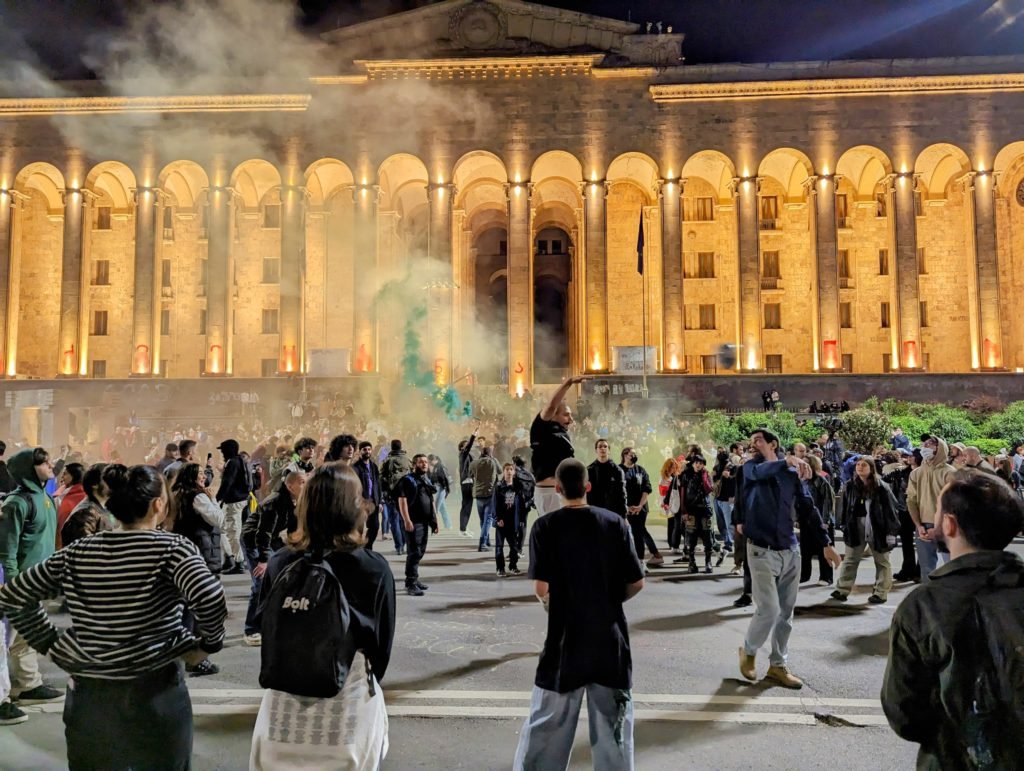
Dispatch – May 22: Catcher in the Rye
“I have to catch everybody if they start to go over the cliff–I mean if they’re running and they don’t look where they’re going I have to come out from somewhere and catch them.
J. D. Salinger, “Catcher in the Rye”
The days in Tbilisi have been pretty much the same all week. Nothing big is planned, but something is definitely going on. Self-organized groups of students marching from point A to point B, other groups from different universities marching from point C to point D. Maybe they’ll meet somewhere, maybe they won’t, maybe they’ll end up on Rustaveli Avenue, maybe they won’t. It’s harder to keep track or make sense of what they’re trying to achieve. Keeping up with them has been physically demanding – but also therapeutic. As each day either brings new abominations or a glimpse of those yet to come, Georgia’s students have carried the nation’s mental health on their backs. It’s as if they were standing at the edge of a cliff, trying to catch those who might fall. But instead of children like in Salinger’s book, it’s adults they’re trying to save – from each other and from their self-sabotaging beliefs.
Here is Nini, and the Dispatch newsletter with updates on a country facing a choice between freedom and autocracy, but also between old and new.
May 20 was a special day. Georgian cities were flooded with teenagers wearing white shirts signed by their peers and teachers to commemorate the “Last Bell” – the last day of school for graduating students. For many, the day marks the entrance into adulthood and the culmination of a year of hard work preparing for university exams. Time goes by fast: those graduating now are the ones who entered the school in 2012, just weeks before Georgian Dream came to power. And now, as they say goodbye to their classrooms, they step outside to find the world turned upside-down – the world that looks the opposite of what they’ve been taught all these years.
The ruling party’s rhetoric does not conform to the laws of logic in which they were trained. Teachers who spent years explaining the errors of the country’s repressive past are now in favor of repeating them. MPs are spreading conspiracy theories that these teenagers stopped to take seriously in sixth grade. The government that ran their education says the students have IQ problems and somehow blames it on the predecessor. The authorities hunt and beat their comrades, label them Satanists, and proceed to kill their future. And while all this unfolds, the teens have a separate struggle with their families, who either deny the reality or, worse, are willing to accept it.
These struggles were the reasons why some decided to bring their celebrations to Tbilisi’s Rustaveli Avenue, in front of the parliament building. The gathering began as a small, scattered rally after 8 pm. But quite spontaneously, the young people found each other, made a circle, held hands, and started moving around energetically, enlivening the place in a few seconds. The scene looked familiar – yet, somehow, refreshingly new. It’s far from the first time young protesters have done this. The activity, inspired in part by the Georgian war dance Khorumi, has become a routine part of recent youth-led rallies. And while the activity initially drew much admiration and smiles, some may now be developing a fear that with all the dangers facing the country, the dancing is becoming somewhat silly.

What’s the Grand Plan?
The anxiety is normal: the pace at which the young people are dancing and marching can only be matched by the speed with which things have fallen apart in the country in recent weeks. The government has gone rogue. It feels free to do things it once prided itself on not doing, including wanton campaigns of physical violence and intimidation. Things that used to work – international pressure, massive local protests, shaming – have stopped working. Civil society is at a loss, while opposition politicians seem stuck in their neverending regrouping.
Against this backdrop, the dwindling number of young people dancing must seem like the last and least efficient thing to do. Smiles turn to frowns. Government supporters refuse to believe that the youth are acting on their own without some kind of malicious hand guiding them. Government critics find it increasingly difficult to see how marching and dancing can lead to victory. Calls for a specific “plan” – an integral part of past years’ protest movements that GD has learned to wait out – are resurfacing.
Probably what many mean by “plan” is more about the upcoming October elections and how the fragmented opposition could try and defeat the GD despite the 5 percent threshold and the campaign environment that promises to be unfree. Will they present a unified list of all opposition parties or offer more diversity at the ballot box? One must accommodate the fears of those who dread crossing anything with the name of a current or former United National Movement politician on it, but too much fragmentation risks leaving many votes unrepresented. Another consensus is not to allow another round of one-party rule, whoever wins. And there’s further uncertainty on how – and whether – the plan must blend in with the current protest movement, or rather focus on discussing future policies and specific arrangements should the opposition win the elections.
- Read more about current uncertainties in our recent article.
But no matter how big and grand that plan is, the dancing youth may still be the key difference-makers. These grand plans have been around for twelve years; many have been tested and repeatedly proven flawed. That “mature” guidance comes from outdated policy manuals that have consistently favored ad hoc management over substantive transformation and have excessively relied on international pressure instead of working hard to build a stronger, inclusive, participatory, and resilient society at home.
Throbber Icons
To overcome and, more importantly, to prevent such existential crises, the country doesn’t need a new plan as much as it needs new politics. Will the generational change finally do the job before it’s too late? It would be an exaggeration to say that current rallies are turning into forums for discussing political philosophy. The ideas articulated by the new protesters are also not very different from those of the older generations. Yet, a sense of independence and agency, which implies a distrust of the old rules of the game and a refusal to take seriously strategies that failed to prevent all this, might be a good place to start.
Less than five months remain before the crucial elections. It seems like a short time, but for the way things work in Georgia, it could mean eternity. Will these dancing circles of young people finally replace the vicious circles the country has been walking in all these years?
The visual of a turning circle does look like a “throbber,” an icon that suggests something is loading … Or it can also evoke associations of a collective effort to open a new portal, to break through to the other, brighter side … Or a tornado to suck in others, like passive or undecided voters (the engagement of the youth and the response of the government has already made some supporters of the ruling party reconsider their stances).
Anyway, dear Gen-Z, keep doing those “silly” dances: you can’t be doing it wrong if no one knows what you’re doing! Keep catching us as we again head into the abyss without thinking too much about whether it makes any sense….or whether we deserve to be caught at all.
